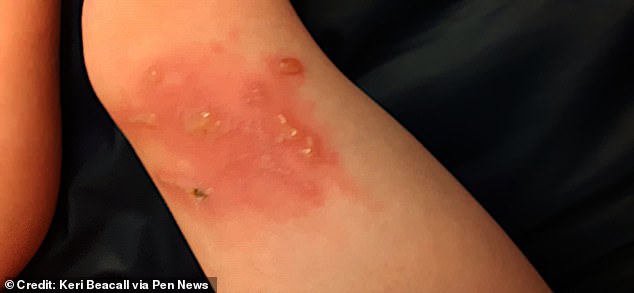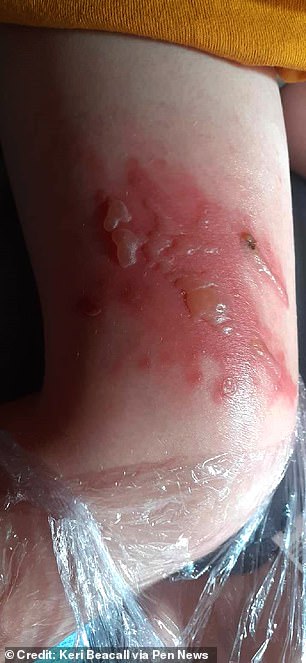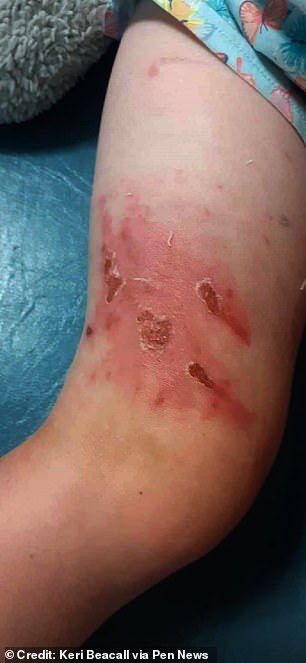Britain’s ‘most dangerous plant’ strikes again: girl, 4, left with painful burns to her legs after accidentally brushing past giant hogweed
>
A child was scarred for life after a moment of contact with ‘Britain’s most dangerous plant’.
Aurora Waters, four, was visiting Delamere Forest, Cheshire, when she started complaining of pain in her legs.
Mom, Keri Beacall, initially assumed her daughter was tired, but when she took Aurora to the bathroom, she discovered the true cause.
Her child had brushed past the dreaded giant hogweed – and although she had been wearing leggings – the plant sap had reached her.
The next day, as her wounds worsened, Aurora was taken to Arrowe Park Hospital, which sent her on to the burn unit at Alder Hey Children’s Hospital.
A child was scarred for life after a moment of contact with ‘Britain’s most dangerous plant’. Aurora Waters, four, was visiting Delamere Forest, Cheshire, when she started complaining of pain in her legs

Her child had brushed past the dreaded giant hogweed – and although she had been wearing leggings – the juice from the plant had reached her
Keri, 40, said: ‘It was really bad then. The whole thing was just blisters, and they popped and turned black. That was the worst.
She was definitely in pain from it until they cleaned it. She constantly complained that it hurt her.
“It really scarred her mentally. She’s a little tomboy who likes to climb, and now it’s just a constant “mom, is that bear claw?”
“It’s just heartbreaking because normally she doesn’t know fear.
“They said it would scar her for life. Because she’s red, she has very light skin, so it stands out too.’
The sap of the giant hogweed prevents the skin from protecting itself against the sun’s rays, leading to horrific burns when exposed to natural light.
Part of what makes it so dangerous is that it often doesn’t cause immediate pain, meaning its victims can continue to burn in the sun without any problem.

Keri was told by medics that the Aurora’s injuries were somewhere between a burn from boiling water and a burn caused by fire.


Giant hogweed sap prevents the skin from protecting itself from the sun’s rays, leading to horrific burns when exposed to natural light
Keri was told by medics that the Aurora’s injuries were somewhere between a burn from boiling water and a burn caused by fire.
She is horrified to think how bad her daughter’s injuries would have been had her skin not been partially protected by leggings.
She said, “I usually always put her in shorts and t-shirts; all summer she has worn shorts.
“But on this day it was raining, and something—I don’t know what—told me to put leggings on her.
“I think, If I hadn’t put those leggings on her, how much worse would it have been? Because it would have been directly on her skin.’
Now Birkenhead’s mother is speaking out to warn other parents about the dangers of giant hogweed.


“It was heartbreaking to see what my daughter went through,” she said. “Literally, we just walked. She walked past it and she literally brushed past it’
“It was heartbreaking to see what my daughter went through,” she said.
“Literally, we just walked. She walked past it and she literally brushed past it.
“I just want to make parents aware of how dangerous this plant is, because there are plenty of kids like my little girl who run through the woods and love to explore.”
A spokesman for Forestry England, which manages Delamere Forest, said they were not aware that anyone had been burned by giant hogweed at the site, nor that the plant was present there.
They said: ‘Recently during their visit a minor developed rash-like symptoms and the child was given first aid by our recreation team and advised to seek medical attention.
However, the cause of the rash was unknown.
‘For the forests and forest areas that we manage, where giant hogweed is present, we have drawn up a management plan, including the installation of safety signage.
“Where giant hogweed is found in very busy public areas, including popular recreational destinations like Delamere Forest, it would be removed immediately.”
A spokesperson for Cheshire West and Chester Council is urging anyone who suspects they have seen giant hogweed to report it.
They said: ‘All confirmed reports of giant hogweed will be placed on a list for eradication treatment and monitoring thereafter.
“As soon as a reported sighting comes in, we inspect to confirm the species is giant hogweed and treat it as a priority to eliminate.”
The giant hogweed is native to the Caucasus, but was introduced to Britain as an ornamental plant in 1817 and its spread is now out of control.
Mike Duddy of the Mersey Basin Rivers Trust said in 2015 that giant hogweed was ‘without doubt the most dangerous plant in Britain’.
If you are exposed to the plant, wash the area that has made contact thoroughly and keep it out of the sun for a few days, advises the Woodland Trust.
